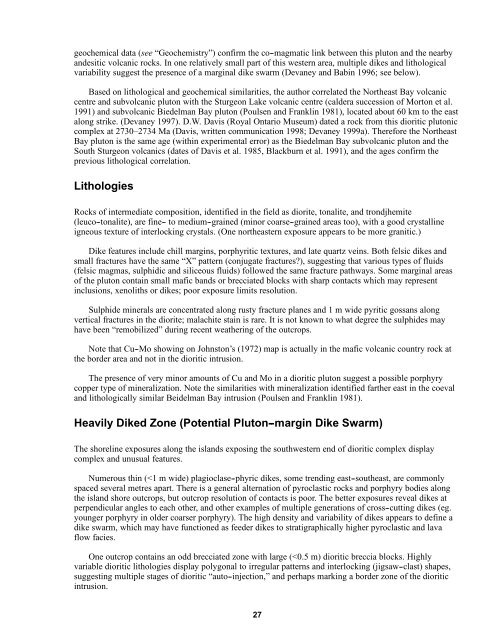Regional Geology, Sioux Lookout Orogenic Belt - Geology Ontario
Regional Geology, Sioux Lookout Orogenic Belt - Geology Ontario
Regional Geology, Sioux Lookout Orogenic Belt - Geology Ontario
Create successful ePaper yourself
Turn your PDF publications into a flip-book with our unique Google optimized e-Paper software.
geochemical data (see “Geochemistry”) confirm the co--magmatic link between this pluton and the nearby<br />
andesitic volcanic rocks. In one relatively small part of this western area, multiple dikes and lithological<br />
variability suggest the presence of a marginal dike swarm (Devaney and Babin 1996; see below).<br />
Based on lithological and geochemical similarities, the author correlated the Northeast Bay volcanic<br />
centre and subvolcanic pluton with the Sturgeon Lake volcanic centre (caldera succession of Morton et al.<br />
1991) and subvolcanic Biedelman Bay pluton (Poulsen and Franklin 1981), located about 60 km to the east<br />
along strike. (Devaney 1997). D.W. Davis (Royal <strong>Ontario</strong> Museum) dated a rock from this dioritic plutonic<br />
complex at 2730–2734 Ma (Davis, written communication 1998; Devaney 1999a). Therefore the Northeast<br />
Bay pluton is the same age (within experimental error) as the Biedelman Bay subvolcanic pluton and the<br />
South Sturgeon volcanics (dates of Davis et al. 1985, Blackburn et al. 1991), and the ages confirm the<br />
previous lithological correlation.<br />
Lithologies<br />
Rocks of intermediate composition, identified in the field as diorite, tonalite, and trondjhemite<br />
(leuco--tonalite), are fine-- to medium--grained (minor coarse--grained areas too), with a good crystalline<br />
igneous texture of interlocking crystals. (One northeastern exposure appears to be more granitic.)<br />
Dike features include chill margins, porphyritic textures, and late quartz veins. Both felsic dikes and<br />
small fractures have the same “X” pattern (conjugate fractures?), suggesting that various types of fluids<br />
(felsic magmas, sulphidic and siliceous fluids) followed the same fracture pathways. Some marginal areas<br />
of the pluton contain small mafic bands or brecciated blocks with sharp contacts which may represent<br />
inclusions, xenoliths or dikes; poor exposure limits resolution.<br />
Sulphide minerals are concentrated along rusty fracture planes and 1 m wide pyritic gossans along<br />
vertical fractures in the diorite; malachite stain is rare. It is not known to what degree the sulphides may<br />
have been “remobilized” during recent weathering of the outcrops.<br />
Note that Cu--Mo showing on Johnston’s (1972) map is actually in the mafic volcanic country rock at<br />
the border area and not in the dioritic intrusion.<br />
The presence of very minor amounts of Cu and Mo in a dioritic pluton suggest a possible porphyry<br />
copper type of mineralization. Note the similarities with mineralization identified farther east in the coeval<br />
and lithologically similar Beidelman Bay intrusion (Poulsen and Franklin 1981).<br />
Heavily Diked Zone (Potential Pluton--margin Dike Swarm)<br />
The shoreline exposures along the islands exposing the southwestern end of dioritic complex display<br />
complex and unusual features.<br />
Numerous thin (

















